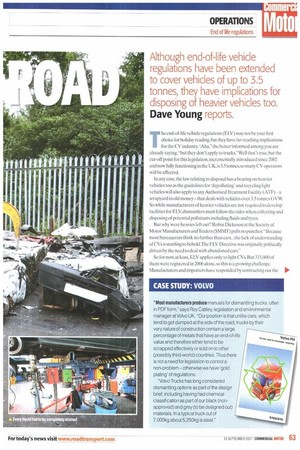Although end-of-life vehicle regulations have been extended to cover vehicles
Page 63

Page 64

If you've noticed an error in this article please click here to report it so we can fix it.
of up to 3.5 tonnes, they have implications for disposing of heavier vehicles too.
Dave Young reports.
Eirf he end-of-life vehicle regulations (ELV) may not be your first choice for holiday reading, but they have far-reaching implications for the CV industry."Aha," the better informed among you are already saying,"but they don't apply to trucks."Well that's true, but the cut-off point for this legislation, incrementally introduced since 2002 and now fully functioning in the CK,is 3.5 tonnes, so many CV operators will be affected.
In any case. the law relating to disposal has a bearing on heavier vehicles too as the guidelines for depolluting' and recycling light vehicles will also apply to any Authorised Treatment Facility (ATF)a scrapyard in old money that deals with vehicles over 3,5 tonnes GVW So while manufacturers of heavier vehicles are not required to develop facilities for ELV, dismantlers must follow the rules when collecting and disposing of potential pollutants including fluids and tyres.
But why were heavies left out? Robin Dickeson at the Society of Motor Manufacturers and Traders (SMMT) pulls no punches: "Because most bureaucrats think no further than cars.., the lack of understanding of CVs is startling to behold.The ELV Directive was originally politically driven by the need to deal with abandoned cars."
So for now, at least, ELV applies only to light CVs. But 333,000 of them were registered in 2006 alone, so this is a growing challenge. Manufacturers and importers have responded by contracting out the 11110 PLASTICS CODES FOR A TYPICAL CAB disposal of their brands to approved ATEs, which will collect vehicles for scrapping and issue a certificate of destruction.
There's a widespread perception of the manufacturing industry as an evil polluting empire but in the UK, at least, this is far from the case. Vehicle manufacturers are increasingly aware of the financial benefits of reusable resources not to mention the brownie points for brands demonstrating environmental awareness.
(13°1"etbY1 methaMlaie) Uniform licensing PP= Polypropene Duncan Wheems,secretary of the Motor Vehicle Dismantlers Association, explains:"The UK government in the form of DEFRA [Department for Environment, Food and Rural Affairs] decided to license all dismantling sites uniformly, and in the UK not EC -law these need to be licensed to do so in a professional manner." In practice main dealers take back vehicles from their franchise free of charge, no matter how old they are. So in theory a 1953 Ford would come under the auspices of ELV and would be disposed of by its manufacturer.
"Most CVs are not abandoned but dismantled by business people who know the commercial value," Wheems points out. "A lot of van and truck spares are exported.
"ELV dismantlers are controlled by the Environment Agency, which is subject to guidance from the DTI [Department of Trade and Industry].They tend to pursue enforcement on licensed breakers with more energy than they apply to unlicensed operators,"Wheems comments wryly. -There is the technical capacity for using plastics but not yet a commodity market. [They are] moving that way but haven't got a business model.
"Currently dealers subcontract ELV to a network of service providers that pay dealers and the final owner for vehicles. Their business depends on the volatility of material markets. ATFs take out




























































































































































































